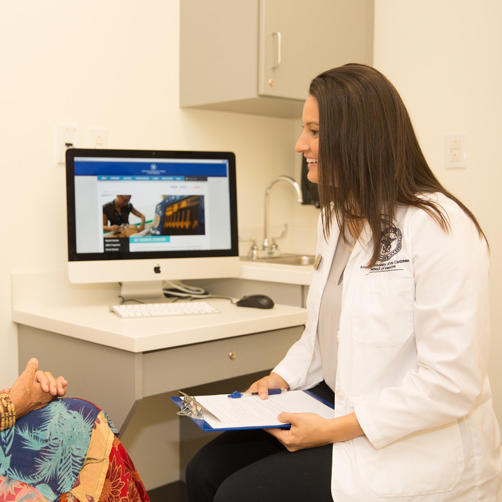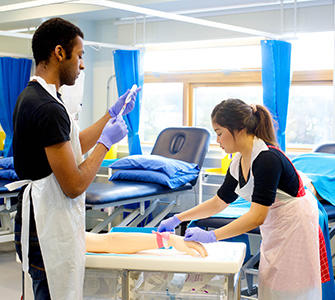Anesthesiologists are medical doctors who specialize in anesthesia, pain management, and critical care medicine. They often administer anesthesia to induce unconsciousness or numbness to patients undergoing invasive medical procedures. To ensure they can provide optimal and safe care to patients, aspiring anesthesiologists undergo extensive education and training.
Anesthesiologists spend 12 to 14 years in school and training after high school.
Generally, anesthesiologists spend:
- 4 years in undergraduate school
- 4 years in medical school
- 4 years in residency
Anesthesiologists may choose to participate in a fellowship program to gain additional training in an anesthesiology subspecialty.
4 Years for Undergrad
Many students interested in becoming anesthesiologists choose to pursue premed tracks as they earn their four-year degree. While premed students can major in any subject, most choose a math or science major to complement their premed concentration. As students complete their undergraduate coursework, they are encouraged to begin volunteering to gain hands-on experience.
Students can gain volunteer hours by shadowing local physicians or volunteering at local clinics, nursing homes, or hospitals.
During this time, students also prepare for the Medical College Admission Test® (MCAT®). Premed coursework may help prepare students for the MCAT, but it is primarily focused on preparing students for medical school. To better prepare for the test, premed students often use MCAT prep materials and take practice tests.
This can be a lot of material to cover in a short amount of time. Students can take the MCAT during their junior year of undergraduate studies or during a gap year. Students may retake the MCAT, but each score will be reported when students apply to medical school. AUC provides additional information and resources on the MCAT.
4 Years for Medical School
Aspiring anesthesiologists can apply to a Doctor of Medicine (MD) or a Doctor of Osteopathy (DO) medical school program. Both programs cover medical sciences, clinical rotations, and require students to pass the two phases of a medical licensing exam. Graduates of both programs can apply for their medical license to be considered a medical doctor.
After years 1 and 2, students must pass the first section of a licensing exam. MD students must pass Step 1 of the United States Medical Licensing Exam® (USMLE®). DO students must pass Level 1 of the Comprehensive Osteopathic Medical Licensing Examination of the United States (COMLEX-USA).
Once students pass Step 1 of the USMLE or Level 1 of the COMLEX, they continue to their clinical rotations. During their rotations, students treat real patients and gain experience in various medical specialties. When students complete their rotations, they are eligible to take USMLE Step 2 CK or COMLEX-USA Level 2.
4 Years for Residency
Residency provides post-graduate medical training and helps graduates, known as medical interns, transition from student to physician. Anesthesiology residencies help students gain hands-on experience providing care before, during, and after surgery. Their schedule may also require working through various specialties such as neurosurgery, obstetrics, pediatrics, general surgery, and more.
“I had a great connection with this program,” Dr. Tayo Akadiri, MD ‘20 says. “In my interview, I could tell that the program director and staff truly cared about the residents, valued their input, and were invested in helping residents achieve their goals.”
After the first year of residency, medical interns are eligible to take USMLE Step 3 or COMLEX-USA Level 3. Once graduates pass the final level of their licensing exam, they will be licensed to practice medicine. In the second and third years of residency, interns are now referred to as residents.
As residents, they spend the rest of their residency gaining experience in their chosen subspecialty. Anesthesiologists can specialize in:
- Adult and Pediatric Cardiac Anesthesiology
- Pediatric Anesthesiology
- Clinical Informatics
- Critical Care Medicine
- Neurocritical Care
- Obstetric Anesthesiology
- Pain Medicine
- Regional Anesthesiology and Acute Pain Medicine
Board-certification is completed through the American Board of Anesthesiology (ABA).
ABA Board Certification Requirements
Those seeking ABA certification must complete a written and oral examination. Residents can take the BASIC exam after their first year of anesthesia residency (CA-1/PGY-2 year). This exam focuses on the scientific basis of clinic anesthetic practice, including pharmacology, physiology, anatomy, anesthesia equipment and monitoring.
After the completion of residency with good standing, physicians can sit for the ADVANCED Exam. The written portion focuses on the clinical aspects of the anesthetic practice, subspecialty-based practice, and advanced clinical issues. Once physicians pass this section, they must take the APPLIED exam.
The APPLIED exam includes the traditional Standardized Oral Examination (SOE) and the Objective Structured Clinical Examination (OSCE). Upon completion, the physician is a board-certified Anesthesiologist. Physicians can only take their written subspecialty board certification examination after they pass all three sections of the ABA exam.
“[The ABA certification exam was] the most grueling but rewarding process of examinations in all of my medical training. Hours, days, months of hard work across all fields of medicine leading to an indescribable feeling of accomplishment . Anesthesiology creates the most well-rounded physician in my humble opinion. It truly is a great specialty that I encourage all to pursue with the right and determined mindset.” - Dr. Dustin Reynolds, MD ‘16
Optional: 1-2 Years for a Fellowship Program
After earning their board-certification, anesthesiologists may begin applying for jobs and working. If anesthesiologists want to further their subspecialty expertise, they can enroll in an anesthesiology fellowship. It provides additional research opportunities and clinical training.
Next Steps
Although aspiring anesthesiologists can anticipate spending 12 to 14 years in school, the time will pass quickly.
American University of the Caribbean School of Medicine’s (AUC) offers a four-year MD program. Years one and twp combine medical sciences with high-fidelity simulations to help students develop clinical reasoning. Years three and four allow students to operate as vital members of teams composed of students, residents, and attending physicians.
Ready to start training to become a doctor? Reach out to AUC today.
This post was medically reviewed by Dr. Dustin Reynolds, MD (’16)





